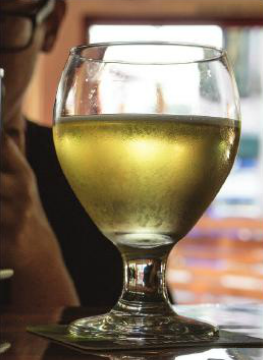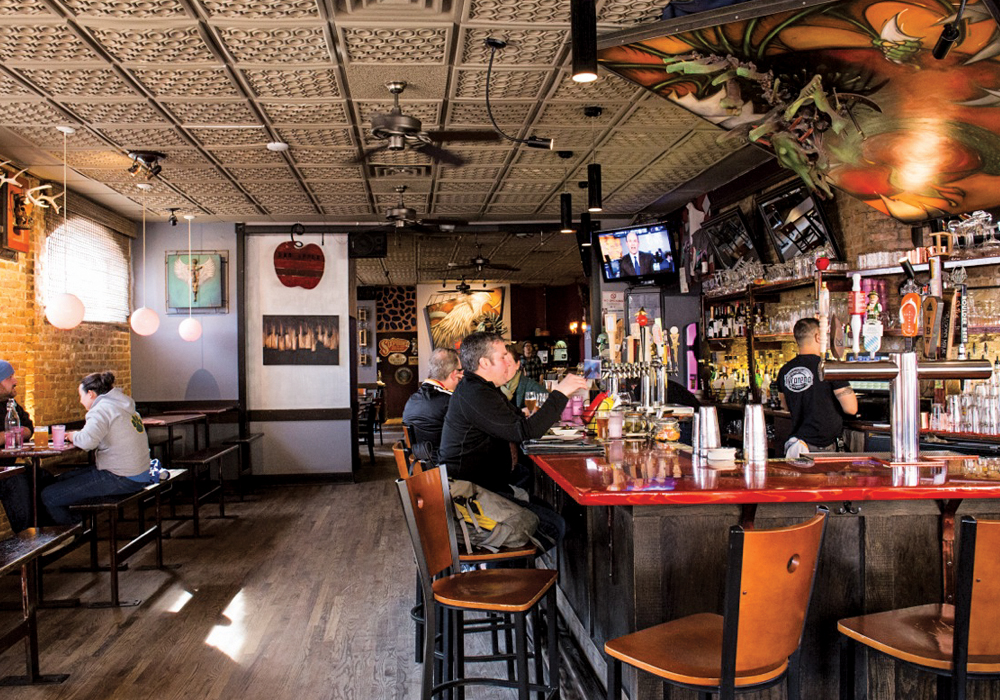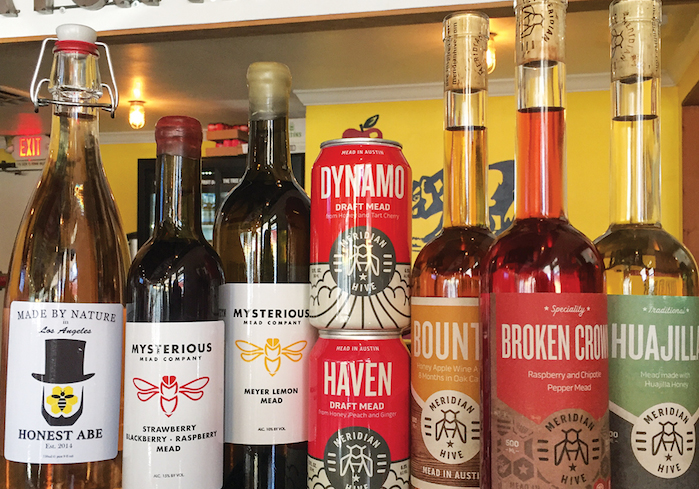Editor’s note: occasionally we bring you on-premise stories from our sister publication Cheers, since most alcohol trends begin at bars and restaurants.
Honey mead dates back to the dawn of civilization, but there is nothing antiquated about its place in the modern bar or restaurant. Mead can be served on draft like beer or from a bottle. It can be mixed into cocktails, and it pairs well with certain foods.
Mead is essentiually fermented honey water. Ancient civilizations drank mead, and its traces have been discovered in pottery from China to Europe. Within the historical documents that describe mead, drinking it would likely commemorate a victory or feast.
More recently, mead was better known as a saccharine elixir poured at Renaissance festivals. But thanks to the craft beverage movement, mead is outgrowing some of its negative connotations and is earning a place as an artisanal drink among well-made beer, wine and cocktails.
Mead Market

The number of commercial meaderies in the U.S. increased tenfold in just over a decade, from about 30 in 2003 to close to 300 in early 2016, according to the American Mead Makers Association. Dozens of wineries and breweries also make mead as a specialty offering.
Krokstrom Klubb and Market in Kansas City, MO, features a mead selection prominently on its menu. General manager Josh Rogers co-owns Krokstrom Klubb with his wife, executive chef Katee McLean, who draws from her Swedish heritage to create modern Scandinavian fare. Including mead was not an afterthought for this couple.
“Since we are a Scandinavian restaurant, we made a decision to always have a great mead selection,” says Rogers “We have five to six bottle and glass options at all times, and rotate through four different draft meads.” Krokstrom Klubb has in fact become a destination for mead, he says.
Mead can also be found at bars with a beer-focused beverage program. The Bad Apple in Chicago serves up to 25 beers on tap along with a lengthy bottle list. Owner Craig Fass has noticed a recent uptick in mead sales. “People have always shown an interest, but I feel that there has definitely been an increase in purchasing over the last year or so,” says Fass.
At One-Eyed Betty’s Beer Bar and Kitchen in Ferndale, MI, general manager Michael Fredenburg attributes increased sales in mead to the season. “We usually see a rise in sales for the summertime where mead is concerned,” says Fredenburg. Some meads that are more sweet than dry are served very cold, making them a good option for warmer days, he notes.
For customers of The Southern Growl in Greer, SC, mead has many advantages. Manager Anna Bowes notes that drinkers looking for a gluten-free option are excited to see mead as a choice. “The mead industry is definitely growing and becoming much more common in the market,” she says.
The Southern Growl is accustomed to introducing people to mead. “Most places don’t have a mead on tap, so our customers are usually intrigued by it. Once they try mead, though, they are most often hooked and seek it out,” says Bowes.
One region that has experienced a booming growth of meaderies is Southern California. San Diego, known for its high number of craft breweries, has seen more than half a dozen meaderies open in the past year, says Brenda Radtke. She and her husband Otto co-own Great Society Cider and Mead, a bar and restaurant in Long Beach, CA, that accommodates vegetarian, vegan and gluten-free diners.
Radtke says the mead industry’s growth has been great. “We also want to support local producers as much as our customers want to buy it,” she notes. “In fact, we’ve made road trips to get undistributed regional meads on tap here at Great Society.”
Money Honey
One of the learning curves that new mead drinkers experience is the price point. Honey, the raw material in mead, is expensive, particularly when it comes from a small local beekeeper.
And mead generally carries a higher-alcohol content than beer or cider, so it requires more fermentable sugar (in this case, honey), to produce. So operators have to price it accordingly.
At Great Society Cider and Mead, for instance, a flight of four 4-oz. ciders is priced at $12, whereas a flight of four 4-oz. meads is $20.
To help people contextualize pricing, Bowes at The Southern Growl frames mead in the context of wine. “Mead has a higher ABV, typically in the 10% to 15% range. Mead is more like a wine and is meant for sipping, so the price is understandable,” she says.
With three meaderies in the immediate area, locals at One-Eyed Betty’s are more familiar than most when it comes to mead, says Fredenburg.
Still, the bar wants to make sure guests understand why mead pours with a heftier price tag, because honey needed to make mead is more expensive than barley malt in beer. “Honey is not cheap, and good honey is even pricier,” says Fredeburg.

A Wide Range of Styles
The American Mead Makers Association outlines 10 styles of mead, from session mead, which has an alcohol content under 10% ABV, to dessert mead, which has over 14% ABV.
There are also different variations on mead ingredients. Some mead styles, called bracket or braggot, can contain malt, while others, such as pyment, contain grape juice. Cyser is an apple cider or juice and mead hybrid.
Klubb Krokstrom offers a range of styles, ranging from session meads to dessert mead. The session meads are comparably priced to other beverages on draft.
Customers have a good handle on what mead is, but Klubb Krokstrom aims to educate drinkers on different types. “The draught styles drink a lot like a hard cider and are less sweet and more dry,” Rogers says.
“We have some that are in the middle and drink almost like a sweet riesling, and on the other end, we have some that are much higher in alcohol and drink like port or dessert wines.”
When drinkers discover a new category such as mead, steering them to the right style is paramount. At Great Society Cider and Mead, the first goal is always familiarizing customers with the product, then servers can get creative.
“Our favorite task is guiding them towards something they really like,” says Radtke. Great Society offers as many as eight meads on tap and even more in bottles. Prices range from $6 to $10 per for draft pour, depending on the source of the mead and alcohol content, which varies from 5.5% ABV to 13% ABV.
Having a variety of styles can make it easier to match a drinker to the style of beverage they are looking for, and employees must be empowered to do so. “We have had to incorporate explanations into our training program for our service staff so they have the tools to explain mead to customers,” says Rogers.
Along with Happy Hour draft selections from $4 to $5, Krokstrom Klubb offers domestic mead on tap for $6 to $8 and domestic and imported bottles for $35 to $45.
There are advantages to serving mead that justify bringing a more expensive product into your bar program—namely, extended shelf life. Rogers keeps that in mind when pouring by the glass.
“One bonus is that once a bottle is opened, it doesn’t oxidize like a wine would. Honey is a natural antioxidant, so you don’t have that issue to deal with,” says Rogers.
He adds that serving temperatures vary; some meads get served cold, others at room temperature.

Mixing with Mead
Whether you offer a sweet mead or one with a drier mouthfeel, you can combine the drink with other beers or liquors to create new cocktails.
Krokstrom Klubb, for instance, has a beverage called The Bee’s Mead, made with Right Swedish gin, Lion’s Tooth dandelion liqueur, lime and Redstone Meadery’s Nectar of the Hops.
Fass at The Bad Apple features two different mead cocktails that illustrate its range of use, both priced at $9. “The first is the Mead-A-Rita,” says Fass. “We make a classic Margarita served on the rocks with salt and add mead to it.”
Guests have a choice of mead from the local Wild Blossom Meadery; The Bad Apple carries the hibiscus, apple cinnamon, and spicy chile—also known as Pirate’s Blood—flavors. Mead works in this cocktail because of the intense flavors in tequila and the balance of acidic citrus and salt, Fass says.
On the other end of the spectrum is The Bad Apple’s Ancient Beverage cocktail, a combination of Benromach Scotch and Dansk Ribe Mjod, which is a Danish mead spiced with apples and hops, served on the rocks. “The smokiness and sweetness play really well together” without overpowering the mead, Fass says.
The Southern Growl offers the Bee My Honey, made with Crafted Artesan Meadery’s Nectar Gose blueberry mead, house-made lemonade and fresh mint. “We are big fans of blending beers together to create unique flavor combinations,” Bowes says. “Mead is super dynamic when it comes to blending, because of its high ABV and intense honey flavor and sweetness.”
Honey is a powerful substance and the nature of mead ingredients ensure its flavors won’t be overshadowed. A traditional mead can be mixed with a West Coast-style IPA to cut the bitterness with sweetness or added to a strong, roasty coffee stout.
You can also combine mead with a puckering sour for an added level of flavor and for a boost to ABV, “which is nice, because most sours are lower ABV,” says Bowes. It’s important to consider the higher alcohol content of many meads, keeping mixed drinks balanced and not too strong for your guests.

Mead with Meals
Consider the basic elements of food pairing when suggesting mead to accompany a dish. Contrast the sweetness of mead with bitter or spicy food, complement the honey flavor with playful selections, or match strength for strength with comparably flavored treats. Like beer or wine, because of the different variations within the mead category, not every selection can be used interchangeably.
“Mead pairs well with spicy food, hearty foods and rich cheeses,” says Fass. “It goes well with a lot of our burgers.” He recommend mead with the “Figs Is In” burger, which is topped with a fig and bacon relish, smoked onions, and goat cheese.
“It is also amazing with our meat and cheese plate,” Fass adds, noting that The Bad Apple makes its own dry-cured meats in house.
Fredenburg lays out his goals for pairing mead at One-Eyed Betty’s. “When pairing mead, my first notion would be to contrast it, something spicy or earthy, maybe something hearty or fat-laden,” he says.
Fish would work as a pairing, he notes, as long as the mead itself was dry and light enough. A high-alcohol, sweet mead will mellow out a spicy dish. But go with a lighter choice for delicate meat and proteins. “And of course there is always dessert; a big sweet mead just begs for some doughnuts, cake or pie,” adds Fredenburg.
“Dessert is the easiest pairing option, because honey makes everything from ice cream to creme brûlée better,” says Bowes. Try a mead with coffee added, such as Moonlight Meadery’s Coffee in Bed, with a Belgian Liege Waffle or a buttery biscuit, she suggests.
After dessert, mead can be served as a digestif, or with cheese. “Makana Meadery from South Africa makes some of the best meads we’ve ever tasted, with layers upon layers of flavors,” Bowes says. Southern Growl currently carries Makana’s Cape White Fig mead on tap, “and the rich honey and fig are out of this world with intense cheeses like brie or chevrelait (smoked goat gouda),” she says.
Whether you suggest mead as a way to close a meal or begin it, to balance out cocktails with bold flavors, or on its own, served right on tap along side beer and cider, mead can round out and enliven a beverage program. Learn about the history of the drink and its artisanal future by sourcing from meaderies in your area and abroad.
Mead may not yet be on the radar for many consumers, but increasing awareness will contine to boost demand, says Radtke. Once guests walk in to Great Society Cider and Mead, “mead’s high ABV, that it’s made from honey, and that it is hard to find anywhere else on tap regionally help us break that barrier,” she says.
Erika Bolden is a freelance writer and certified beer server. She is a frequent contributor to L.A. Weekly, West Coaster SoCal and All About Beer magazine.




